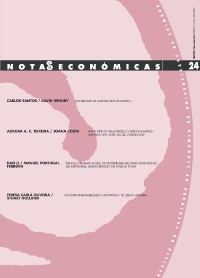Please use this identifier to cite or link to this item:
https://hdl.handle.net/10316.2/26019| DC Field | Value | Language |
|---|---|---|
| dc.contributor.author | Santos, Carlos | - |
| dc.contributor.author | Hendry, David | - |
| dc.date.accessioned | 2013-09-26T09:54:56Z | |
| dc.date.accessioned | 2020-10-04T14:48:25Z | - |
| dc.date.available | 2013-09-26T09:54:56Z | |
| dc.date.available | 2020-10-04T14:48:25Z | - |
| dc.date.issued | 2006 | - |
| dc.identifier.issn | 2183-203X | - |
| dc.identifier.uri | https://hdl.handle.net/10316.2/26019 | - |
| dc.description.abstract | Neste artigo estendemos a ideia base do algorítmo de saturação de modelos com variáveis indicadores a um tipo particular de modelos dinâmicos. Demonstra-se que o procedimento mantém o nível de significância real correcto para processos AR(1) estacionários, independentemente do número de partições da amostra usado. Derivamos a potência teórica em face de um outlier de tipo aditivo e apresentamos evidência de Monte Carlo que demonstra uma boa taxa de rejeição empírica da hipótese nula nesse caso. É apresentado um conjunto extenso de simulações de Monte Carlo que evidenciam que o procedimento tem uma potência apreciável quando existe quebra na média condicional do processo nas últimas rT% observações da amostra. Este resultado não depende do nível de autocorrelação das observações, nem da utilização de um mal especificado modelo do tipo location-scale, abrindo assim as portas a uma nova classe de testes automáticos de quebras de estrutura que poderão revelar-se melhores que testes do tipo de Bai-Perron em pequenas amostras. | por |
| dc.description.abstract | In this paper, we extend the impulse saturation algorithm to a class of dynamic models. We show that the procedure is still correctly sized for stationary AR(1) processes, independently of the number of splits used for sample partitions. We derive theoretical power when there is an additive outlier in the data, and present simulation evidence showing good empirical rejection frequencies against such an alternative. Extensive Monte Carlo evidence is presented to document that the procedure has good power against a level shift in the last rT% of the sample observations. This result does not depend on the level of serial correlation of the data and does not require the use of a (mis-specified) location- scale model, thus opening the door to an automatic class of break tests that could outperform those of the Bai-Perron type. | eng |
| dc.language.iso | eng | - |
| dc.publisher | Faculdade de Economia da Universidade de Coimbra | - |
| dc.title | Saturation in Autoregressive Models | por |
| dc.type | article | - |
| uc.publication.collection | Notas Económicas nº 24 | - |
| uc.publication.firstPage | 8 | - |
| uc.publication.issue | 24 | - |
| uc.publication.lastPage | 19 | - |
| uc.publication.location | Coimbra | - |
| uc.publication.journalTitle | Notas Económicas | - |
| uc.publication.orderno | 1 | - |
| uc.publication.area | Ciências Sociais | - |
| uc.publication.manifest | https://dl.uc.pt/json/iiif/10316.2/26019/266503/manifest?manifest=/json/iiif/10316.2/26019/266503/manifest | - |
| uc.publication.thumbnail | https://dl.uc.pt/retrieve/12114027 | - |
| item.grantfulltext | open | - |
| item.fulltext | With Fulltext | - |
| Appears in Collections: | Notas Económicas | |
Files in This Item:
| File | Description | Size | Format | |
|---|---|---|---|---|
| notaseconomicas24_artigo1.pdf | 342.19 kB | Adobe PDF |  |
Items in DSpace are protected by copyright, with all rights reserved, unless otherwise indicated.
